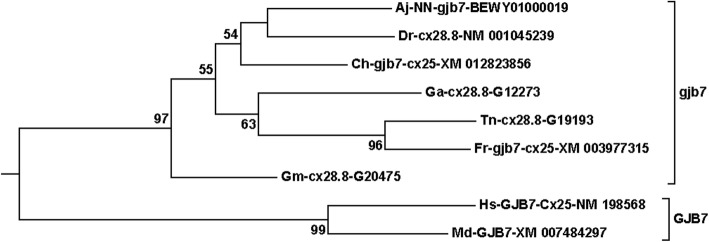Fig. 2.
The GJB7/gjb7 branch from the compressed tree shown in Fig. 1. This is an example of a group where all teleost species have only one member, and therefore probably have lost the expected ohnolog partner at a very early stage before the divergence of the different teleosts, similar to most of the other connexins located on the same chromosome (see Table 2). The naming of the sequences is as follows. The two-letter abbreviation indicates the species (Aj, Anguilla japonica = Japanese eel; Dr., Danio rerio = zebrafish; Ch, Clupea harengus = Atlantic herring; Ga, Gasterosteus aculeatus = three-spined stickleback; Tn, Tetraodon nigroviridis = green spotted pufferfish; Fr, Takifugu rubripes = Fugu (Japanese pufferfish); Gm, Gadus morhua = Atlantic cod; Hs, Homo sapiens = human; Md, Monodelphis domestica = opossum) followed by an abbreviation of the name of the sequence in the database (using upper and lower case letters as indicated in the database), and finally, the accession number in the database. NN indicates that there was No Name for the sequence in the database. Further details about the naming are found in the Methods section

